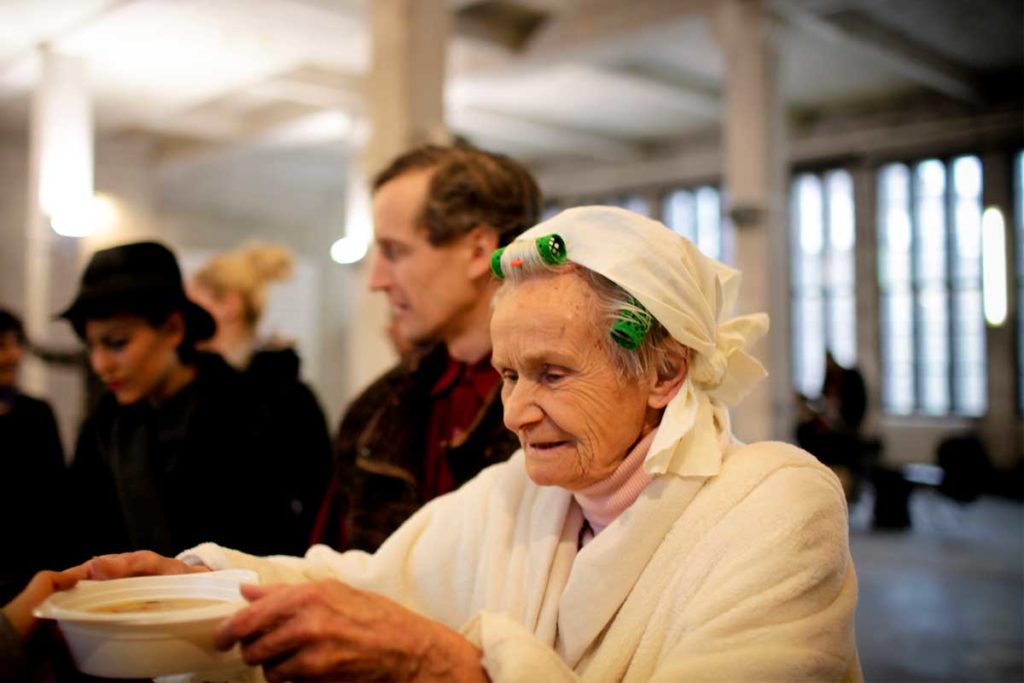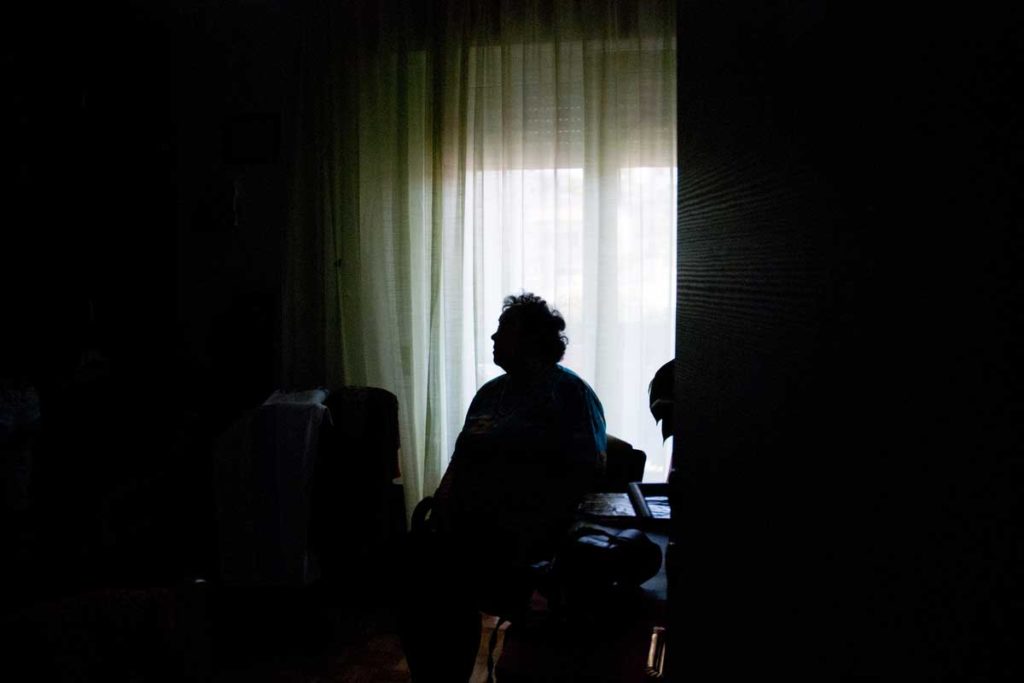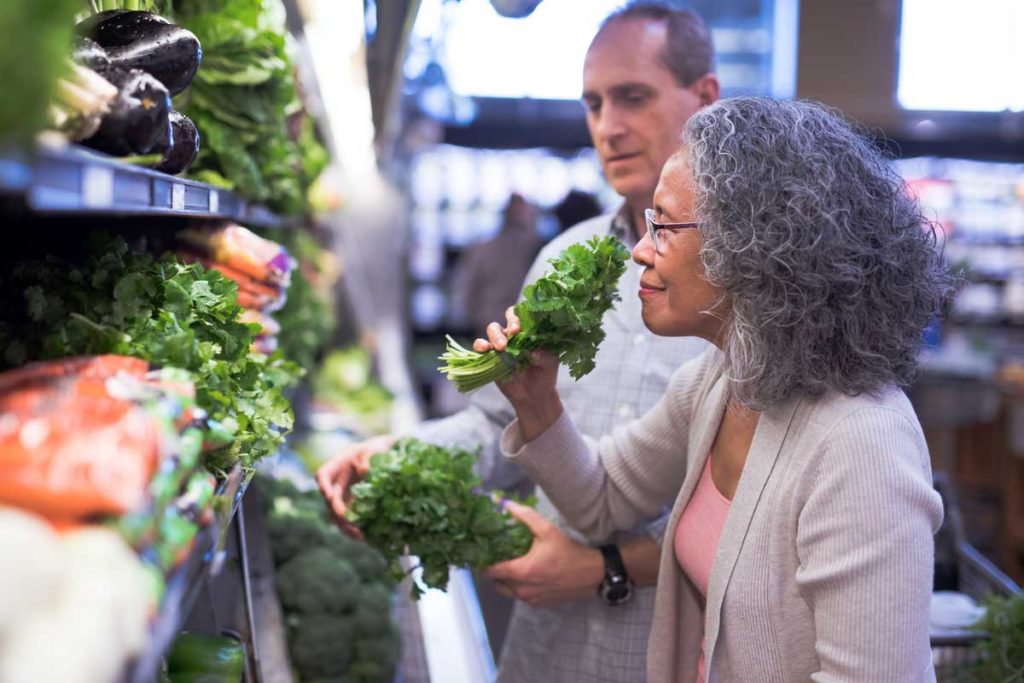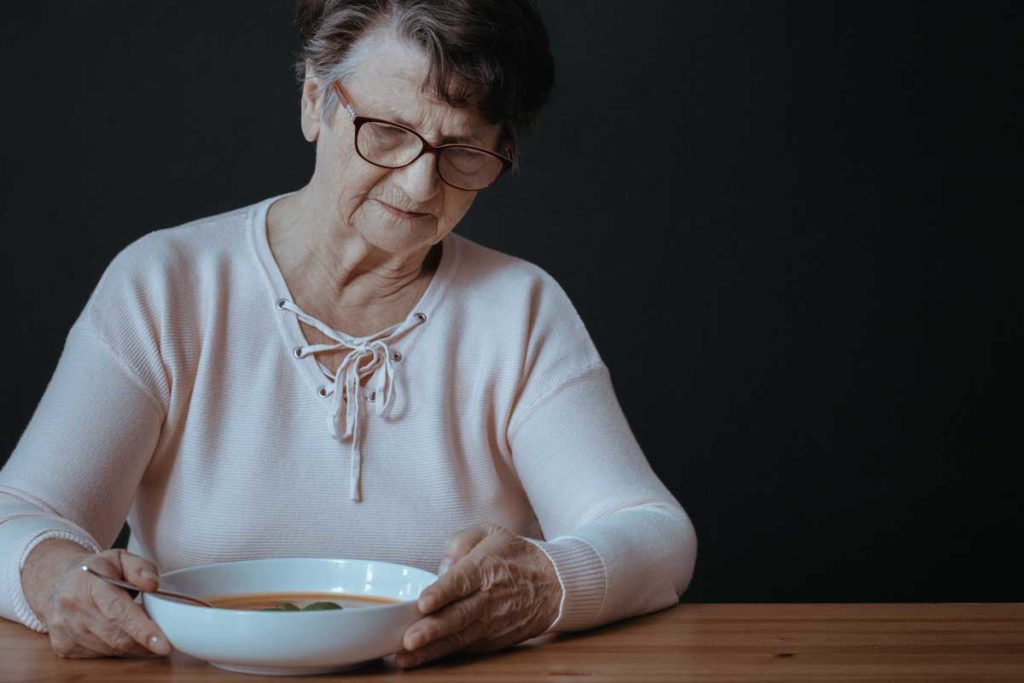To understand the concept of seniors being hungry, you must understand what it means to be food insecure.
Senior hunger is an expansive issue that requires an understanding of exactly what constitutes a senior being “hungry,” the issues that stem from senior hunger, and how seniors who are hungry can be helped.
Seniors Being Hungry is a Nationwide Epidemic
To understand the concept of seniors being hungry, you must understand what it means to be “food insecure.” When you are food insecure, it means that there is “limited or uncertain availability of nutritionally adequate and safe foods or limited or uncertain ability to acquire acceptable foods in socially acceptable ways,” as defined by a study published in The Journal of Nutrition. Essentially, it means that you aren’t receiving and/or don’t have access to the necessary foods and nutrients to help sustain your life.
The concept of being “hungry” is a state-of-mind, meaning that there is a physical aspect to the lack of food. Attending to an area where people are hungry and basically starving is a much more immediate and severe problem to solve. Being food insecure, on the other hand, helps include people who may have enough food and don’t technically live consistently in hunger, but the food they are eating—usually in large amounts—isn’t up to nutritional and dietary standards.
In 2006, the USDA broke down food insecurity into two categories to help determine how food insecure someone is:
Low Food Security

While there may not be an overall reduction in how much food someone is intaking, there may be a lower quality and variety of your diet. For instance, there may be reduced amounts of fresh vegetables and meats, but that may be replaced with fast food. In this category, people don’t miss many meals, but the type of meals that are being eaten diminish in quality.
Very Low Food Security

When you have very low food security, your health and ability to correct it with healthy food is in a dire situation. To be assigned this categorization, the USDA says there must be “multiple indications of disrupted eating patterns and reduced food intake,” meaning you’re often missing meals and not eating enough to survive.

The Numbers Behind Senior Hunger
Not only is senior hunger such a large issue now, the threat of it persisting as a problem into the future is high because of the high rate of seniors expected to exist.
In 2017, there are just more than 49 million Americans age 65 and over, and about 8 million of them can be considered facing the threat of hunger.
Not only is senior hunger such a large issue now, the threat of it persisting as a problem into the future is high because of the high rate of seniors expected to exist. As seniors lost million dollars in the stock market through the 2007 economic recession, their wealth–including retirement funds, insurance payouts, and pension checks–plummeted. This increased the rate at which seniors spent money on lesser quality food in favor of other things like insurance.
In 2014, the National Foundation to End Senior Hunger (NFESH) reported the following facts:
16%
Of seniors “face the threat of hunger,” meaning they’re at some level of food insecurity
65%
Increase in hunger among the senior populations from 2007 to 2014, which is credited partially to the economic recession that started in 2007
55,000,000
Seniors are expected to be in America by 2020, according to the U.S. Census Bureau
80,000,000
Seniors are expected to take up 20% of the population by 2050
Are Some Seniors More Affected than Others?
More than 50 percent of seniors who are at-risk of being food insecure live above the poverty line.
An even deeper issue with senior hunger, aside from how many seniors it affects, is how disproportionately the food insecurity is spread out amongst race, class levels, and geographic location. Let’s take a look at some of the factors that contribute to how certain seniors are more affected than the others.
Class
NFESH performed a deep analysis of the level of food insecurity among seniors in 2008. Within the report is the role seniors’ closeness to the poverty line plays in how food insecure they are, whether they are marginally food insecure, food insecure, or very low food secure. For example, nearly 80 percent of seniors “below 50 percent of the poverty line,” which in 2013 was $15,510 for a two-person household, were at some level of food insecurity.
While food insecurity rates dropped closer to and above the poverty line, the report clarifies that “hunger cuts across the income spectrum.” More than 50 percent of seniors who are at-risk of being food insecure live above the poverty line.
Craig Gundersen, a professor at the University of Illinois and food security expert, says that the main areas where food insecurity is increasing the most is among Americans making less than $30,000 per year and those between the ages of 60 and 69.
Gundersen blames the increase in food insecurity rates to many things, but primarily there was a decrease in wages and overall net worth after the recession in the late 2000s. Many seniors lost mass amounts of money when the stock markets crashed, and as they’re entering retirement, they didn’t have the time to recover. “Most of them can’t rely on Social Security income, and can’t receive Medicare until they are 65,” Gundersen said.
A Census Bureau report from 2011 notes that about 15 percent of seniors (about one in six) live in poverty, based on a “supplemental poverty measure” that adjusts the poverty level to modern day living expenses. This is important because you are more likely to develop an illness like cancer or heart disease—both often linked to your overall health— when you live in poverty.

Race
Food deserts often fall in poorer areas of the country, which further fuels the food insecurity levels due to class
Another issue with senior hunger—and food insecurity in general—is how much race affects the likelihood that you are food insecure. And this is directly tied to class level, as minorities often live in lower income brackets. While the AARP points out that, as you age, the rate of food insecurity raises among all races and ethnicities, there are still those who experience food insecurity at much higher rates.
The aforementioned 2008 report of food insecurity found that African-American seniors were far more likely to have some sort of level of food insecurity than white seniors (almost 50 percent compared to 16 percent) and that Hispanics were more likely to live at some level of food insecurity than non-Hispanics (40 percent compared to 17 percent).
“African-American households are two to two-and-a-half times as likely to be in one of the three categories as the typical senior household,” the report clarified, also noting that Hispanics face similar odds. It’s also more likely in both these minority groups for someone to be food insecure if they are widowed or divorced and live alone.
Food Deserts
As mentioned, there are also certain parts of the country that are more likely to be food insecure than others. Areas where access for fresh produce and food is the most limited are known as “food deserts.” Not only does this include the absence of fresh food, but food deserts also include areas where access to food is inhibited because of the lack of grocery stores or the lack of transportation to get to one.
Food deserts often fall in poorer areas of the country, which further fuels the food insecurity levels due to class.
All but one of the top 10 states for food insecurity are in the South or Midwest. These states match a map of the United States that shows the high concentrations of food deserts. In many of the states with high levels of food insecurity, there are also counties with larger concentrations of areas where there is no supermarket within a mile of people who don’t have a car. For instance, in many counties in Arkansas, Alabama, and Louisiana, more than 10 percent of the population without a car doesn’t have a supermarket within a mile.
This severely affects an individual’s health. Those who lived more than 1.75 miles from a grocery store actually turned out to have a higher body mass index (BMI) than those who lived closer to one, a 2006 study found.

The Challenges that Can Cause Senior Hunger
There are many things that living alone can do to spur food insecurity, such as not having someone else to help get food from the store if you’re lacking mobility and cook it for you.
As we’ve seen, there are socioeconomic reasons why a senior may be food insecure, and we just looked at some of the main ones. But there are plenty of other factors that may cause someone to not get the proper food they need to maintain their health:
Living Alone

According to a 2012 report, nearly half of the senior households that experienced food insecurity were those where a senior was living alone. There are many things that living alone can do to spur food insecurity, such as not having someone else to help get food from the store if you’re lacking mobility and cook it for you. Living alone also factors into depression and the development of dementia, both of which have side effects of the suppression of hunger. The NFESH study backs this up as well, noting that “those living alone are twice as likely to experience hunger compared to married seniors.”
Age
Seniors aged below 70 are more likely to experience bouts of food security than those aged 70 and up. The NFESH report showed that as seniors aged, they were less likely to be any level of food insecure, with those under 70 (20 percent) living at some level of food insecurity than those over 80 (14 percent). This can be attributed to many factors, such as the amount of money received from government programs like Medicare (which help alleviate medical costs so more money can be spent on food) and whether or not they live in an assisted living facility, which may help with more consistent eating habits.
Education Level

Those with a high school degree or no high school degree at all are more likely to experience some sort of food security than those with a college degree. There is a stark drop off of food insecurity levels with someone who at least has some college education. This can be tied to getting paid higher wages at jobs, which then translates to the potential of having more money saved up when you’re older.

Overall, senior women are slightly more likely to be food insecure than men, but the rates are not vast enough to be a determining factor in the likelihood of food insecurity. All of these factors, though—from the big ones like geographic location and race to the smaller ones like age—play into seniors’ overall health, a detrimental factor to how long seniors will live.
Illnesses Caused by Malnourishment
As seniors become more food insecure, they also become more likely to develop diseases and illness that could cut their life short. Feeding America, a nonprofit organization that focuses on hunger issues across the country, took a look at various illness that were more likely to occur when seniors lived with food insecurity. We’ll dive into those illness—along with a couple more—that can stem from eating poor food and eating at an infrequent rate.
Depression
According to a 2017 report from Feeding America, food-insecure seniors are 60 percent more likely to suffer from depression than food-secure seniors. Another study from the AARP determined that food insecure people were nearly three times more likely to suffer from depression.
Some of the leading causes of depression include having conflicts in your interpersonal relationships and life-altering events that completely shift your life, typically trending negative. The inability to provide consistent healthy food for yourself or your family can lead to depression. This is because though you may have once lived food secure, you are constantly worrying about making sure you’re going to have some sort of food on your plate for your next meal. Years of worrying about your next meal can take a toll and put you in a constant depressive mood. If you do suffer from depression, a side effect is a suppressed hunger, and that can further worsen your health—it’s a vicious cycle.

Heart Disease
There are many negative effects food insecurity has on the heart, both from a level of stress and other physiological aspects. The Feeding America study found that seniors who suffer from food insecurity were 40 percent more likely to experience congestive heart failure, where the heart ceases pumping blood around the body at a necessary pace. This is a direct result of the quality of food eaten among food-insecure seniors and how lacking the necessary nutrient—especially when older—can play a role in exacerbating dire health issues.
The inconsistency at which food-insecure seniors eat also fuels stress levels that have negative effects on the heart as they’re consistently worrying about their next meal. The American Heart Association notes that prolonged stress can increase your risk of high blood pressure, overeating, and the lack of physical activity—all leading causes of heart disease. So just as the type of food you’re eating can have physical effects, food insecurity can also have psychological and physiological effects because of the situation at hand.
But these heart issues don’t start once you’re older. The Center for Disease Control conducted a 10-year study on 30 to 59 year olds and the relationship between their levels of food security and their heart. The study found that those with very low food security were far more likely to develop a cardiovascular disease that those who were at least marginally food secure. This shows that health problems associated with food insecurity, while prevalent in seniors, can begin with prolonged exposure to food insecurity.
Diabetes
The overall quality of food—and how inconsistently it’s eaten—plays a role in developing type 2 diabetes in seniors.
A 2012 study, which analyzed the role food insecurity plays in cardiometabolic disease (a disease that increases the risk of diabetes), points out that some aspects of food insecurity include binge eating food when it becomes available and eating energy-dense food, which can put an overall unhealthy strain on the heart and contribute to becoming diabetic. In 2013 and 2014 alone, a separate study found that food-insecure seniors were nearly twice as likely to be diabetic than food-secure seniors. Overall, it concluded that food-insecure seniors were 65 percent more likely to be diabetic.
Not only does food insecurity increase the risk of diabetes, it’s also difficult for a diabetic person to afford a diet that supports diabetes when they are food insecure. When concluding that food insecurity is an independent risk factor in developing diabetes, the study said: “This risk may be partially attributable to increased difficulty following a diabetes-appropriate diet and increased emotional distress regarding capacity for successful diabetes self-management.”
Limited Activities Of Daily Living
The presence of food insecurity has been found to negatively affect seniors’ ability to complete these ADLs, which hinders their ability to continue to live on their own.
Food insecurity among seniors generally affects how they can live their day-to-day lives. Sidney Katz, a physician from the mid-1900s, developed the concept of Activities for Daily Living (ADLs) that helps determine how functional an elderly person is and whether or not they are able to support themselves or not. The six detrimental ADLs to an elderly person include:
- Bathing
- Personal hygiene
- Going to the bathroom
- Sleeping on their own
- Mobility (getting in and out of bed, walking, etc.)
- Being able to feed themselves
The presence of food insecurity has been found to negatively affect seniors’ ability to complete these ADLs, which hinders their ability to continue to live on their own. An NFESH study found that food-insecure seniors were 30 percent more likely to report at least one ADL limitation, and this is largely fueled from being unable to physically get to the store and purchase food. This can then affect a senior’s health and take its toll on other ADLs, such as the ability to go to the bathroom on their own.

Organizations Working to End Senior Hunger
There are organizations seeking to end senior hunger and decrease levels of food insecurity among the senior population.
There are ways to combat senior hunger, and there are thousands of workers out there to help stemming from non-profit and governmental organizations.
The primary organization you should know about if you’re a food-insecure senior—or suffer from food insecurity at all—is the Supplemental Nutrition Assistance Program (SNAP), also known more commonly as food stamps. SNAP assists low-income citizens with getting the necessary food they need.
As of 2014, it was found that less than 50 percent of the elderly eligible for the program were enrolled, which is a staggeringly low number. The government is willing and able to help seniors suffering from food insecurity. You can visit the benefits website to see if you are eligible for the programs and apply.

There are also organizations seeking to end senior hunger and decrease levels of food insecurity among the senior population. Some of these include the National Foundation to End Senior Hunger, Meals on Wheels and other food delivery services, USDA services, and AARP:
NFESH
The National Foundation to End Senior Hunger is a large non-profit organization dedicated directly to putting an end to senior hunger. Their vision statement is as follows: “We will identify and assess this challenge in communities through funding senior-specific research, fostering local collaboration and engaging diverse partners. We foresee the creation of tangible, replicable solutions in ending senior hunger to meet the needs of an aging population.”
Food Delivery Service
Government organizations like the USDA started services that bring food to seniors who don’t have the means of getting to a grocery store. There are also organizations like Meals on Wheels that help deliver healthy meals to people of all ages, including seniors.
USDA Services
In addition to developing programs that help get food to seniors’ doorsteps, the USDA offers services that provide financial help to seniors to get the necessary nutritious and fresh food they need to maintain health. These programs include the Senior Farmers Market Nutrition Program, the Nutrition Services Incentive Program, and the Commodity Supplemental Food Program.
Healthy Eating Tips to Remember
In addition to looking for assistance from organizations, there are steps you can take when buying your groceries to ensure that the money is spent on the proper healthy foods.
Primarily, you must know what you’re looking for when you enter a grocery store, so it’s important to make a list. This way, you won’t deviate from the plan of buying healthy foods. Make sure to look out for deals on healthy food, and buy multiples of one product if it’s non-perishable so you don’t have to make a trip back for the same deal.

It’s also important to not waste any food. If you are buying vegetables and produce in bulk, put them to use and prepare multiple meals at one time. It’s also perfectly fine to freeze meats for months at a time, so buy a few more pounds than you originally planned and put it in the freezer for several weeks from when you buy it.
You should also know exactly what you’re buying. Make sure to not load up on food that is high in carbohydrates. This can contribute to weight gain and cause you to accidentally skip meals if you are too full from previous meals. You should also compare labels when choosing between products. The products with lower sugar and sodium levels are typically better for you than their counterparts.
With these tips and the information presented above in mind, hopefully we as a society can move closer to ending hunger for seniors and our nation as a whole.
